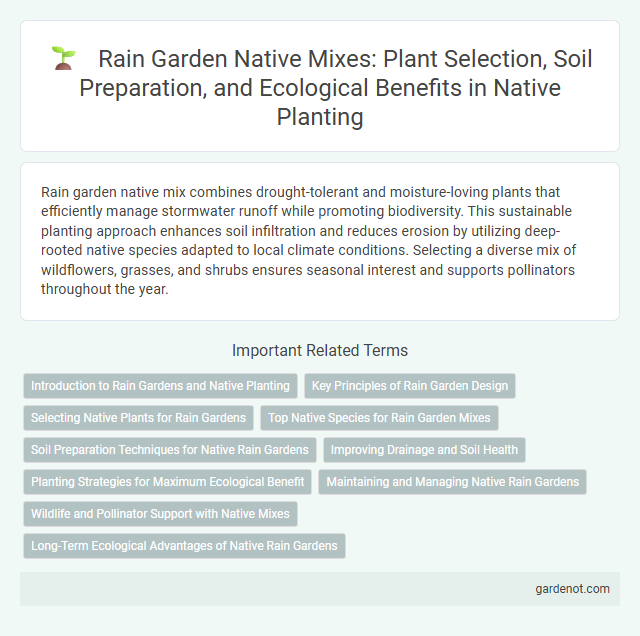Rain garden native mix combines drought-tolerant and moisture-loving plants that efficiently manage stormwater runoff while promoting biodiversity. This sustainable planting approach enhances soil infiltration and reduces erosion by utilizing deep-rooted native species adapted to local climate conditions. Selecting a diverse mix of wildflowers, grasses, and shrubs ensures seasonal interest and supports pollinators throughout the year.
Introduction to Rain Gardens and Native Planting
Rain gardens utilize native plant mixes designed to enhance water absorption and reduce runoff, supporting local ecosystems and improving water quality. Native plants in rain gardens are adapted to regional climate and soil conditions, requiring less maintenance and providing essential habitat for pollinators and wildlife. These gardens effectively manage stormwater by filtering pollutants through deep-rooted native vegetation, promoting sustainable urban landscaping.
Key Principles of Rain Garden Design
Rain garden native mix selection emphasizes deep-rooted, water-tolerant plant species that enhance infiltration and prevent erosion. Key principles of rain garden design include proper site assessment, soil permeability analysis, and creating a graded basin to manage stormwater runoff effectively. Integrating native plants with varying root depths optimizes water absorption and supports local biodiversity.
Selecting Native Plants for Rain Gardens
Selecting native plants for rain gardens involves choosing species that thrive in local soil and moisture conditions while effectively absorbing runoff. Plants like switchgrass (Panicum virgatum), blue flag iris (Iris versicolor), and swamp milkweed (Asclepias incarnata) are ideal for their deep root systems and tolerance to fluctuating water levels. Incorporating a diverse native mix enhances biodiversity, improves water infiltration, and reduces erosion in rain garden ecosystems.
Top Native Species for Rain Garden Mixes
Top native species for rain garden mixes include prairie plants like Purple Coneflower (Echinacea purpurea), Switchgrass (Panicum virgatum), and Blue Flag Iris (Iris versicolor) known for their deep root systems that enhance water infiltration. These species thrive in fluctuating moisture conditions, helping to filter pollutants and reduce runoff. Incorporating Goldenrod (Solidago spp.) and Joe-Pye Weed (Eutrochium purpureum) promotes biodiversity and supports local pollinators while maintaining soil stability in rain gardens.
Soil Preparation Techniques for Native Rain Gardens
Effective soil preparation techniques for native rain gardens include deep loosening of compacted soil to enhance water infiltration and root penetration, followed by the incorporation of organic matter such as compost to improve soil structure and nutrient availability. Testing soil pH and amending it to suit native plant requirements ensures optimal growth conditions, while avoiding excessive fertilization maintains the natural ecosystem balance. Creating gently sloped or bermed areas aids in directing and retaining rainwater, facilitating sustained moisture for native plant mixes adapted to local hydrological cycles.
Improving Drainage and Soil Health
Rain garden native mixes improve drainage by incorporating deep-rooted native plants that enhance soil permeability and reduce surface runoff. These native species support beneficial soil microbes, promoting nutrient cycling and increasing organic matter content. Properly designed rain gardens with native plants mitigate flooding risks while boosting soil health through natural filtration and aeration processes.
Planting Strategies for Maximum Ecological Benefit
Selecting diverse native species with varying root depths in a rain garden native mix enhances soil filtration and water retention. Incorporating pollinator-attracting plants and seasonal bloomers supports local wildlife and maintains year-round ecological balance. Strategic spacing and layering mimic natural habitats, reducing erosion and promoting resilient, self-sustaining ecosystems.
Maintaining and Managing Native Rain Gardens
Maintaining and managing native rain garden mixes involves regular monitoring of plant health and soil moisture to promote optimal water infiltration and pollutant removal. Pruning invasive species and removing accumulated debris ensures native plants thrive and prevents competition that can disrupt ecosystem balance. Seasonal mulching and minimal supplemental watering during drought periods support native root systems and enhance the garden's resilience.
Wildlife and Pollinator Support with Native Mixes
Rain garden native mixes are specifically designed to enhance wildlife habitats and support pollinators by incorporating diverse native plant species adapted to local conditions. These mixes typically include flowering perennials, grasses, and shrubs that provide nectar, pollen, and shelter for bees, butterflies, and other pollinators throughout the growing season. Native plant diversity in rain gardens improves ecosystem resilience, water management, and promotes biodiversity in urban and suburban landscapes.
Long-Term Ecological Advantages of Native Rain Gardens
Native rain garden mixes support long-term ecological balance by enhancing biodiversity and promoting native pollinators. These plantings improve stormwater absorption, reducing runoff and preventing soil erosion while naturally filtering pollutants. Establishing native rain gardens strengthens local ecosystems and fosters sustainable wildlife habitats over time.
Rain garden native mix Infographic

 gardenot.com
gardenot.com